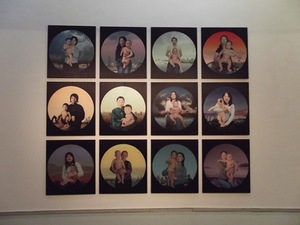MADONNA WITH CHILD IN THE ORIENTAL EYES 3
In brief: The artwork “Twelve Moons” by artist Gao Yuan (Taiwan / USA) is presented at Kaunas Biennial “Textile’11: Rewind-Play-Forward”. Twelve circled coloured photographs are printed on black square silk pieces. They depict Chinese women holding their babies in urban backgrounds.
The author used the subject of Madonna and child as a discovery and creative inspiration. Influenced by the Renaissance masterpieces, seen in Italy, the artist decided to incorporate the subject into the Eastern cultural space. The concept of two worlds is represented in the artwork – religious (Christian) and astrological (Signs of Zodiac, celestial bodies). Chinese women and children are involved into the composition instead of Jesus and Mary.
The composition and content of Madonna and child has been used, transformed and questioned in non-religious contexts since the 20th c. Modernism (Salvador Dali, Mark Chagall, Edvard Munch, etc.). Exhibitions, cycles, separate artworks, analysing the topic, are frequent in Lithuania too. One of the newest examples is the exhibition “Contemporary Madonnas” by Jurgita Juodytė, taking place at 101 Gallery in Kaunas.
As distinct from Lithuanian artists, Gao Yuan moved the Christian subject into the Eastern culture and traditions. The artwork suggests that the relationship between the mother and child is the foundation of mankind. The motherliness is imagined the same in different cultures. Revealing motherliness rather than divinity is also the main aim of the religious subject.
The author found it important to reveal the commonness of symbols in art and periodic movement of life. The circle – the sun, the moon, the wheel – is a universal archetypical symbol. The sun and the moon are perceived as astrological signs. Gao is depicting moons in her work. The moon is related to women and associated with fertility, pregnancy and birth. Besides, the circle symbolises family for the artist (Chinese eat at a round table).
Every baby in Gao Yuan’s work is marked with tattoos of different Chinese Zodiac signs. The tattoos accentuate the Eastern iconography and represent identity.
Another aspect of the topic – change and periodicity – is also significant in the work. Chinese women with children are forced to move from city to city because their husbands can find job only in newly-build cities. Migrating Chinese women as if remind of the pilgrimage of the St. Family. Gao depicted rising skyscrapers behind the figures in order to express the idea of children, growing as fast as cities. That is why she chose to photograph babies from three to eight years old. The moon has its cycles, the year has months that replace each other; just as children are born, grow up and die, and the wheel of life spins again, and the image of a new city changes the old one.
Fundamental principles of Western and Eastern culture meet in this artwork, making it the document of different civilisations or the process of globalisation. Its interpretation depends on our experience and philosophy.
A similar confrontation of cultures could be noticed in the work “A Heart Divided” by another participant of Kaunas Biennial – Fiona Kirkwood. Two identities intertwine – Scottish and South African (the result of globalisation). The artist conveys cyclic thinking, energies of different cultures and includes little round symbolical and iconic images from her life.
Using the technique of textile, mariological subject and archetypical symbols, Gao Yuan reveals the deepest wish of women – growing children. Eastern women are more capable of depicting motherliness because their culture is closer to “mother-nature”. Meanwhile, Western women are more distant from traditions and are braver to destroy them.
In conclusion, intercultural background of the artwork shows not only the commonness and differences of various cultures and art forms but also reveals new outlook towards conventional iconographies and extends the possibilities of using them. New meanings are created and old are transmitted. Fusing images of different cultures is the phenomenon of the 20-21st c. that unites the world through art and answers to universal, global and eternal problems.

